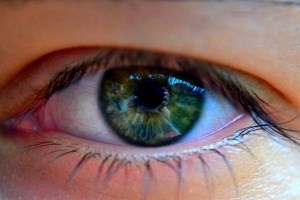So here is the scene ... I am sitting in a brutally hard chair in the front of a starkly lit room with 25 intense therapists staring at me with excruciatingly empathetic looks on their faces. What I choose to believe was empathy may more likely have been relief. They were all likely saying a silent prayer of gratitude that I volunteered to be the guinea pig during this demonstration. It was terrifying.
The trainer is sitting in front of me. He says, with what I can only describe as an indifferent tone, "Tell me about something disturbing that happened in your life."
Now the purpose of this demonstration is not to dive into my childhood trauma or emotional pain. Although in that moment, I'm not sure I believed him. He just wanted to set up how an EMDR therapy session would start. I didn't know how far he was going to take this demonstration so I was more than a little nervous. I had no desire to be reduced to a sobbing mess in front of this group of strangers and professional colleagues.
Anyone who knows me personally knows that tears come freely to me in personal situations. So in front of this crowd I am painfully aware that, like most people in the world, I have unresolved stuff that may come flooding to the surface in the hands of a good therapist. This man is a well-respected and very talented EMDR therapist. I was convinced that he could see right into the darkest depths of my soul. The shame was in the back of my throat.
For those of you interested, EMDR stands for Eye Movement Desensitization and Reprocessing. In many ways the therapy sounds a lot like voodoo witch magic. It isn't. I have been very skeptical but I have heard enough positive things about it that I sought out the training to help me make up my own mind. It is a protocol for therapy that focuses on resolving trauma and anxiety. I love having new tools in my therapy toolbox but I don't always like the work I have to do to learn the new skill.
Sitting in front of the room reminded me of what it is like to be vulnerable. Vulnerability is an unnerving experience for most of us. Being vulnerable usually makes us look at our shame up close. This was a good reminder of what my clients must feel like when they first come to see me or what many of us are experiencing at this time of year.
The beginning of September is a time of year that many of us are facing new adventures: school starting, work schedules, the change of seasons and getting back into a routine. This can bring excitement for some, anxiety for others and a mix of the two for most of us. It is a time of year that many of us are vulnerable and are ashamed of that vulnerability.
I believe that vulnerability is the key to happiness. I remember the first time I saw Brené Brown's TEDTalk on shame and vulnerability. If you haven't seen it, it is 20 minutes well spent.Basically she speaks about how the difference between people who live their lives with all their heart and those who struggle to find happiness. The difference is that people who are the happiest and most content are willing to embrace vulnerability. They are willing to experience and share their suffering as well as their joy and celebration.
I see this every day. The people who have the courage to dive into their grief, abuse and loss history are the ones who find their way. They deal with their emotions head on.
I have talked with people with far more trauma than I could ever handle and they do fine. I have seen some who buckle under seemingly mild stress. The difference is not bad luck or crappy life circumstances. How we deal with trauma is complicated. It all depends on our life experience, attitude and DNA.
Vulnerability is like Teflon. It helps the crappy life experiences just slide off. Shame is like honey. It makes everything stick. How do we produce more Teflon? It is a good question, one that I try to figure out daily with clients.
I know that vulnerability is contagious. After I got off that hard chair, someone else got on it. Watching people be vulnerable and watching that person experience acceptance and safety as a result catches like a common cold.
Sadly, shame is contagious too. Our society shames people all the time. We are never good enough, smart enough or skinny enough. Either that or we are too good, too smart or too skinny. The infection happens through our words, ridicule and gossip. We infect our co-workers, neighbours, family and – worst of all – our children with it. Instead of reaching out for understanding, we push each other away, especially those people who are different from us in social class, race or ability. It is easier to say "that is your problem" than "tell me more".
How can we stop the pandemic? We can all try to be more vulnerable. Embracing your own vulnerability will not stop bad things from happening and will not be even the least bit comfortable but it will spread and help us all be more human. It will help you live a better life.
Today I sat on on a brutally hard chair in a starkly lit room and I am better for it. I hope the others in the room are too.




